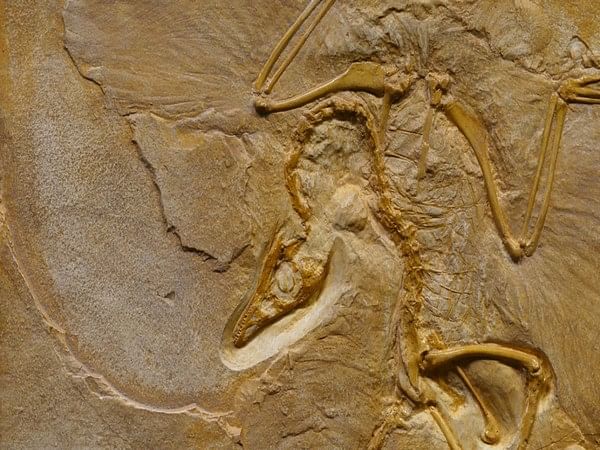Washington [US] December 6 (ANI): A specimen retrieved from a cupboard of the Natural History Museum in London has shown that modern lizards originated in the Late Triassic and not the Middle Jurassic as previously thought.
This fossilised relative of living lizards such as monitor lizards, gila monsters and slow worms was identified in a stored museum collection from the 1950s, including specimens from a quarry near Tortworth in Gloucestershire, South West England. The technology didn’t exist then to expose its contemporary features.
As a modern-type lizard, the new fossil impacts all estimates of the origin of lizards and snakes, together called the Squamata, and affects assumptions about their rates of evolution, and even the key trigger for the origin of the group.
The team, led by Dr David Whiteside of Bristol’s School of Earth Sciences, have named their incredible discovery Cryptovaranoides microlanius meaning ‘small butcher’ in tribute to its jaws that were filled with sharp-edged slicing teeth.
Dr Whiteside explained: “I first spotted the specimen in a cupboard full of Clevosaurus fossils in the storerooms of the Natural History Museum in London where I am a Scientific Associate. This was a common enough fossil reptile, a close relative of the New Zealand Tuatara that is the only survivor of the group, the Rhynchocephalia, that split from the squamates over 240 million years ago.
“Our specimen was simply labelled ‘Clevosaurus and one other reptile.’ As we continued to investigate the specimen, we became more and more convinced that it was actually more closely related to modern day lizards than the Tuatara group.
“We made X-ray scans of the fossils at the University, and this enabled us to reconstruct the fossil in three dimensions, and to see all the tiny bones that were hidden inside the rock.”
Cryptovaranoides is clearly a squamate as it differs from the Rhynchocephalia in the braincase, in the neck vertebrae, in the shoulder region, in the presence of a median upper tooth in the front of the mouth, the way the teeth are set on a shelf in the jaws (rather than fused to the crest of the jaws) and in the skull architecture such as the lack of a lower temporal bar. There is only one major primitive feature not found in modern squamates, an opening on one side of the end of the upper arm bone, the humerus, where an artery and nerve pass through. Cryptovaranoides does have some other, apparently primitive characters such as a few rows of teeth on the bones of the roof of the mouth, but experts have observed the same in the living European Glass lizard and many snakes such as Boas and Pythons have multiple rows of large teeth in the same area. Despite this, it is advanced like most living lizards in its braincase and the bone connections in the skull suggest that it was flexible.
“In terms of significance, our fossil shifts the origin and diversification of squamates back from the Middle Jurassic to the Late Triassic,” says co-author Professor Mike Benton. “This was a time of major restructuring of ecosystems on land, with origins of new plant groups, especially modern-type conifers, as well as new kinds of insects, and some of the first of modern groups such as turtles, crocodilians, dinosaurs, and mammals.
“Adding the oldest modern squamates then completes the picture. It seems these new plants and animals came on the scene as part of a major rebuilding of life on Earth after the end-Permian mass extinction 252 million years ago, and especially the Carnian Pluvial Episode, 232 million years ago when climates fluctuated between wet and dry and caused great perturbation to life.”
PhD research student Sofia Chambi-Trowell commented: “The name of the new animal, Cryptovaranoides microlanius, reflects the hidden nature of the beast in a drawer but also in its likely lifestyle, living in cracks in the limestone on small islands that existed around Bristol at the time. The species name, meaning ‘small butcher,’ refers to its jaws that were filled with sharp-edged slicing teeth and it would have preyed on arthropods and small vertebrates.”
Dr Whiteside concluded: “This is a very special fossil and likely to become one of the most important found in the last few decades. It is fortunate to be held in a National Collection, in this case the Natural History Museum, London. We would like to thank the late Pamela L. Robinson who recovered the fossils from the quarry and did a lot of preparation work on the type specimen and associated bones. It was such a pity she did not have access to CT scanning technology to help her observe all the detail of the specimen.” (ANI)
This report is auto-generated from ANI news service. ThePrint holds no responsibility for its content.



